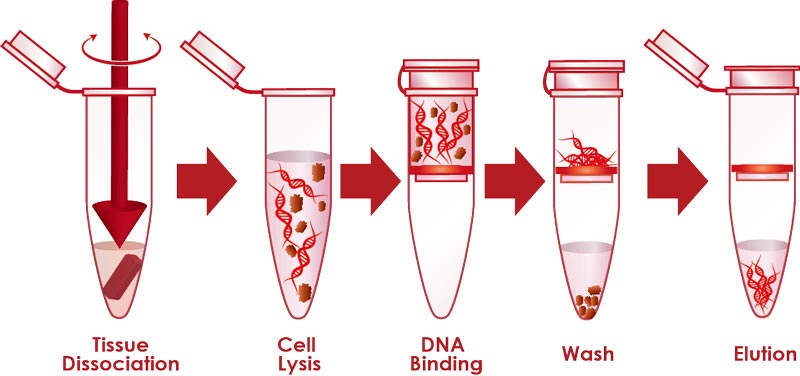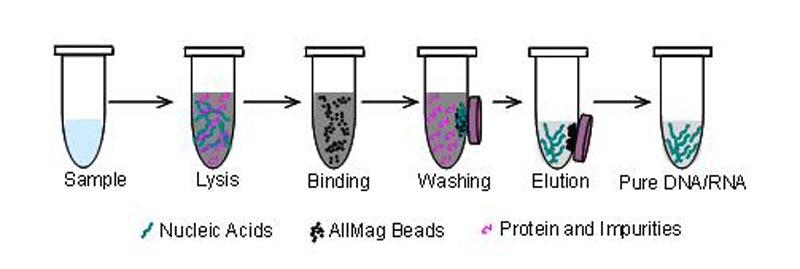With the rapid development of molecular biology technology, molecular diagnostic and detection technologies represented by nucleic acid hybridization, nucleic acid amplification and nucleic acid sequence analysis have become increasingly important in many fields.
As the “first step” of molecular diagnostic experiments, nucleic acid extraction is also the most critical step. The quality of nucleic acids obtained will directly affect the success or failure of downstream molecular biology experiments.
1. Traditional methods of nucleic acid extraction
Since the first discovery of nucleic acids in 1869, many researchers have made unremitting efforts in the extraction of nucleic acids, and have improved various materials and reagents of nucleic acids.
The traditional extraction methods include: phenol extraction and alkali lysis. , CTAB extraction and EtBr-CsCl gradient centrifugation. These traditional extraction methods can separate DNA and RNA from different tissue samples. However, these techniques include steps such as precipitation and centrifugation, which require a large amount of biological samples, and the extraction steps are complicated, time-consuming and labor-intensive, and the yield is not high. Therefore, it is difficult to achieve automated operation. In addition, most of the traditional methods also need to use toxic chemical reagents, which are potentially harmful to the health of operators.
Therefore, along with the development of molecular biology and polymer materials, the conventional techniques for isolating nucleic acids from the liquid phase systems are gradually being replaced by new methods based on solid phase carriers.
2. Solid phase carrier adsorption method
The novel nucleic acid extraction methods based on solid phase adsorbent carriers mainly include: spin column extraction method, glass bead adsorption method, silica matrix method, anion exchange method and nano magnetic bead extraction method.
The operation steps of these kind of methods can be mainly divided into three parts:
(1) using lysate to promote cell rupture, releasing nucleic acid in the liquid phase;
(2) using the carrier’s strong affinity and adsorption force for nucleic acid, nucleic acid will specifically bound to a specific carrier while other impurities such as proteins, polysaccharides and lipids remain in the liquid phase and are removed as the supernatant;
(3) By adjusting the ionic strength of the elute and the pH value, purified nucleic acid adsorbed on the carrier is obtained by eluting.

Among them, the spin column DNA extraction kit is widely used in the market due to its low price and relatively convenient operation. However, with the increasing demand for DNA extraction, the disadvantage of extracting DNA by the centrifugal column method is increasingly prominent. The shortcomings of large sample demand, large loss, inability to do for rare samples, etc., cannot be avoided by the centrifugal column method.
At the same time, the centrifugal extraction method requires repeated centrifugation, which is inconvenient for high-throughput and automated operation, and is incompatible with modern biological experiments. In order to adapt to the high-throughput, high-sensitivity, and automated operation of modern molecular biology, magnetic bead DNA extraction technology was born in the 1990s.
The principle is that the surface of the magnetic beads carries specific reactive groups, these functional groups can specifically reversibly bind to the nucleic acid. At the same time, the magnetic responsiveness possessed by the magnetic bead itself can be conveniently moved and enriched under the action of an external magnetic field, thereby realizing the separation and purification of the nucleic acid.
Magnetic bead DNA extraction is a perfect combination of nanotechnology and biotechnology, with advantages unmatched by other DNA extraction methods:

(1) Low sample demand: a small amount of material can extract a high concentration of nucleic acid;
(2) Simple and fast operation: The whole operation process is basically divided into five steps (cracking, combining, washing, drying, eluting), and the whole process does not require centrifugation, and most of them can be completed within 30~60 minutes;
(3) Stable and reliable quality: the free magnetic beads bind to the nucleic acid more, and the specific binding makes the nucleic acid more pure, and the nucleic acid recovery can be adjusted by controlling the surface groups of the magnetic beads;
(4) Fully automated operation: The nucleic acid extractor can realize automatic and high-throughput operation and one-click start-up can realize the extraction of dozens or even hundreds of samples;
(5) Safe, non-toxic and harmless: the reagents do not contain toxic chemical reagents such as phenol and chloroform, and fully comply with the modern environmental protection concept.
